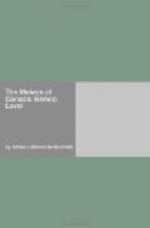In 1692 he devoted his large fortune to the foundation
of a hospital and a school, and received numerous
gifts from charitable persons. Six hospitallers
of the order of St. Joseph of the Cross, commonly called
Freres Charron, took the gown in 1701, and pronounced
their vows in 1704, but the following year they ceased
to receive novices. The minister, M. de Pontchartrain,
thought “the care of the sick is a task better
adapted to women than to men, notwithstanding the spirit
of charity which may animate the latter,” and
he forbade the wearing of the costume adopted by the
hospitallers. Francois Charron, seeing his work
nullified, yielded to the inevitable, and confined
himself to the training of teachers for country parishes.
The existence of this establishment, abandoned by
the mother country to its own strength, was to become
more and more precarious and feeble. Almost all
the hospitallers left the institution to re-enter
the world; the care of the sick was entrusted to the
Sisters. Francois Charron made a journey to France
in order to obtain the union for the purposes of the
hospital of the Brothers of St. Joseph with the Society
of St. Sulpice, but he failed in his efforts.
He obtained, nevertheless, from the regent an annual
subvention of three thousand francs for the training
of school-masters (1718). He busied himself at
once with finding fitting recruits, and collected
eight. The elder sister of our excellent normal
schools of the present day seemed then established
on solid foundations, but it was not to be so.
Brother Charron died on the return voyage, and his
institution, though seconded by the Seminary of St.
Sulpice, after establishing Brothers in several villages
in the environs of Montreal, received from the court
a blow from which it did not recover: the regent
forbade the masters to assume a uniform dress and to
pledge themselves by simple vows. The number
of the hospitallers decreased from year to year, and
in 1731 the royal government withdrew from them the
annual subvention which supported them, however poorly.
Finally their institution, after vainly attempting
to unite with the Brothers of the Christian Doctrine,
ceased to exist in 1745.
Mgr. de Laval so greatly admired the devotion of these
worthy men that he exclaimed one day: “Let
me die in the house of these Brothers; it is a work
plainly inspired by God. I shall die content if
only in dying I may contribute something to the shaping
or maintenance of this establishment.”
Again he wrote: “The good M. Charron gave
us last year one of their Brothers, who rendered great
service to the Mississippi Mission, and he has furnished
us another this year. These acquisitions will
spare the missionaries much labour.... I beg you
to show full gratitude to this worthy servant of God,
who is as affectionately inclined to the missions
and missionaries as if he belonged to our body.
We have even the plan, as well as he, of forming later
a community of their Brothers to aid the missions
and accompany the missionaries on their journeys.
He goes to France and as far as Paris to find and bring
back with him some good recruits to aid him in forming
a community. Render him all the services you
can, as if it were to missionaries themselves.
He is a true servant of God.” Such testimony
is the fairest title to glory for an institution.




